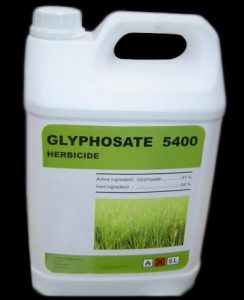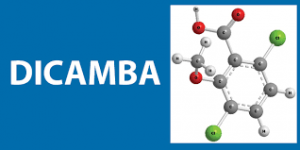- Impacts on Herbicide Use
- Impacts on Insecticide Use
- Net Impacts of GE Crop Technology
- 2012 Environmental Sciences Europe Paper
- Glyphosate Use
- 2,4-D and Dicamba
- Herbicide Timelines Dynamic Presentations

Pesticide use encompasses the applications of herbicides, insecticides, fungicides, soil fumigants, and several other types of pesticides targeting other organisms. Accordingly, the impact of GE crop technology on pesticide use is the net change in total pesticide use brought about by the planting of GE crops, compared to what pesticide use would likely be on cropland planted to non-GE seeds.
Related Keywords:
Impacts on Herbicide Use
Genetically engineered (GE), herbicide-tolerant (HT) cotton and soybeans were commercialized in 1996 and quickly transformed weed management systems. HT corn followed a few years later. Prior to 1996, there had been very little meaningful independent research on the costs, benefits, and risks of GE-HT technology.
The vast majority of HT crops have been modified to tolerate post-emergent applications of the broad-spectrum herbicide glyphosate  (Monsanto’s Roundup, and many other brands). So-called “Roundup Ready” (RR) crops account for around two-thirds of all acres planted globally to GE crops since 1996. As glyphosate use rose sharply, the use of other herbicides declined, at least for the first five to 10 years of steady use.
(Monsanto’s Roundup, and many other brands). So-called “Roundup Ready” (RR) crops account for around two-thirds of all acres planted globally to GE crops since 1996. As glyphosate use rose sharply, the use of other herbicides declined, at least for the first five to 10 years of steady use.
Over time, excessive reliance on one weed management tactic (herbicides), and one herbicide active ingredient (glyphosate), triggered shifts in weed communities to species less sensitive to glyphosate. It also led to the emergence of weed phenotypes that were first partially tolerant of glyphosate, and eventually resistant to it. Both shifts forced conventional farmers to spray additional herbicides, apply some herbicides more than once, and often at higher rates per acre.
Independent weed scientists had warned since the early 1990s that excessive reliance on glyphosate and RR technology would trigger the emergence and spread of resistant weeds, warnings that were dismissed by Monsanto and other industry leaders. Instead, the pesticide-seed industry promised that GE crops would reduce pesticide use, a claim that soon became part of the often-repeated PR advanced by proponents of GE crop technology.
Yet glyphosate is a relatively high-dose herbicide, typically applied at a one-time rate of between 0.66 and 0.75 pounds per acre. As farmers adopted RR crops and came to rely largely on glyphosate, over a dozen low dose (~ 0.1 pound/acre) and another near-dozen very low dose (~ 0.01 pound/acre) herbicides were displaced.
This dramatic shift in herbicide choices led to an obvious question — how could replacing herbicides applied mostly at 0.01 to 0.1 pound/acre with a herbicide (glyphosate) applied at 0.66-0.75 pounds/acre reduce overall herbicide use?
To address this question, Chuck Benbrook began a series of analyses quantifying the impact of GE crops on pesticide use. The resulting reports are listed from most recent to oldest below. The last item below — a 1986 paper in Technology Review paper — is one of the first published discussions of the likely impact of GE-HT technology on herbicide use.
Related Keywords:
Impacts on Insecticide Use

About one-third of all acres planted to GE crops since 1996 have been engineered to express Bacillus thuringiensis (Bt) endotoxins throughout the tissues and roots of corn and cotton plants. So-called Bt corn and cotton manufacture their own, natural bioinsecticide targeting certain Lepidopteran insects like the European corn borer, corn rootworm, and the cotton budworm. See the Ag Biotech section on Bt Transgenic Crops for much more on this technology.
By reducing the need for insecticides targeting insects susceptible insects to the expressed Bt endotoxins, Bt crops reduce the use of conventional insecticides. But they also add insecticidal toxins to the environment and food supply, and hence, the net impact of Bt crops on insecticide use must take both the reduction and expression of Bt toxins into account.
Bt crop technology modestly reduced insecticide use in the first decade of use, but recently has actually increased net use because of the trend toward stacked trait varieties of corn and cotton that express two to six different Bt endotoxins. For example, Monsanto-Dow’s SmartStax corn expresses over 3.5 pounds of Bt toxins per acre, while displacing perhaps 0.2-0.5 pounds of insecticide use.
Bt crop technology has reduced conventional insecticide use modestly for another reason — the pesticide industry has made steady progress since 1996 in discovering and commercializing insecticides that are applied at much lower rates than products typically used before the introduction of Bt corn and cotton. Over the last decade or so, most corn and cotton insecticides displaced by Bt crop technology have been applied at rates at or below 0.2 pound per acre.
Moreover, over the last decade, resistance has spread in many insects targeted by Bt corn and cotton, despite the planting GE varieties expressing multiple Bt traits and coating seeds with one to three insecticidal seed treatment. The declining efficacy of most common Bt traits has forced many farmers to once again spray conventional insecticides, essentially eliminating the once-modest reduction in insecticide use.
Related Keywords:
Net Impact of GE Crop Technology
Nearly all acres planted to Bt corn and cotton are also Roundup Ready. Accordingly, the net impact of GE crop technology on pesticide use must take into account the reduction in conventional insecticide use, the volume of Bt endotoxins expressed, and the net change in herbicide use.
For the first few years of GE crop use, the technology brought about a modest, overall reduction in pesticide use. By the early 2000s, however, increases in herbicide use dwarfed modest reductions in net insecticide use. In each year over the last decade across the three major GE crops (corn, cotton, soybeans), total herbicide use has risen, the volume of Bt endotoxins expressed has gone up, and about one-half the early reduction in insecticide use has fallen by the wayside as more and more farmers spray Bt corn and cotton in the hope of slowing the spread of insects resistant to the Bt endotoxins expressed in GE-Bt crops.
Further details on trends in pesticide use on GE crops are provided in the following sections.
______________________
Benbrook Papers and Reports on the Impact of GE Crops on Pesticide Use:
Benbrook, C. 2016. Trends in the use of glyphosate herbicide in the U.S. and globally. Environ. Sci. Europe 28:3 doi 10.1186/s12302-016-0070-0
Benbrook, C. 2012. “Impacts of Genetically Engineered Crops on Pesticide Use in the U.S. – the First Sixteen Years,” Environmental Sciences-Europe, 24:24.
Benbrook, C. 2009. “Impacts of Genetically Engineered Crops on Pesticide Use in the United States: The First Thirteen Years,” Critical Issue Report, The Organic Center.
Benbrook, C. 2004. “Impacts of Genetically Engineered Crops on Pesticide Use in the United States: The First Eight Years” Ag BioTech InfoNet Technical Paper #6.
Benbrook, C. 2001. “Do GM Crops Mean Less Pesticide Use?”, Pesticide Outlook, Royal Society of Chemistry, October.
Benbrook, C., and Moses, P. 1986. “Engineering Crops to Resist Herbicides,” Technology Review, MIT Press, 89 (8): 55‑61, 79.
The 2012 Environmental Sciences Europe Paper
- The Paper
- WSU Press Release
- “Hard lessons emerge from new study on the impacts of GE crops on pesticide use,” October 2, 2012 WSU Blog Post by Charles Benbrook
Glyphosate Use
 Use of the glyphosate herbicide has increased dramatically in the years since the introduction of glyphosate-tolerant GE crops. Data from the USDA shows that over three quarters of corn acres and nearly all of soybean and cotton crops in the US are now treated with glyphosate.
Use of the glyphosate herbicide has increased dramatically in the years since the introduction of glyphosate-tolerant GE crops. Data from the USDA shows that over three quarters of corn acres and nearly all of soybean and cotton crops in the US are now treated with glyphosate.
Glyphosate is now, by far, the most heavily applied pesticide in the U.S., and globally, in history. Enough glyphosate was applied on U.S. cropland in 2014 to spray about 0.8 pounds of active ingredient on every cropland acre in the country.
Worldwide, enough glyphosate is now applied each year to spray about 0.5 pound of this one herbicide on every cultivated cropland acre on the planet.
The unprecedented volume of glyphosate now applied annually is why concern has grown so acute over the spread of resistant weeds, the collapse of glyphosate-dependent weed management systems, this herbicide’s environmental effects, and human exposures and risk. See the items below for more details.
- “Trends in glyphosate herbicide use in the United States and globally,” Dr. Charles Benbrook (2016). Environmental Sciences Europe 28:3. DOI 10.1186/s12302-016-0070-0
- February 2, 2016 EWG Press Release “Study: Monsanto’s Glyphosate Now Most Heavily Used Weed-Killer in History; Nearly 75 Percent of All Glyphosate Sprayed on Crops in the Last 10 Years”.
- Detailed FAQs on Findings, Health Implications, and Funding
Other Glyphosate Resources:
- “Concerns over use of glyphosate-based herbicides and risks associated with exposures: a consensus statement”, Myers et al., 2016. Environmental Health, 15:19. DOI 10.1186/s12940-016-0117-0).
- The Lowdown on Roundup: Parts I-III, see more below
Related Keywords:
2,4-D and Dicamba
 Problems triggered by the spread of glyphosate-resistant weeds in corn, soybean, and cotton crops continue to worsen. Industry sources project that over 100 million acres in the U.S. are now infested with one or more glyphosate-resistant weed, and over 30 million are infested with two or more. The presence of glyphosate-resistant weeds forces farmers to add additional herbicides to their control programs, and apply herbicides more often and/or at higher rates. Weed control costs have gone up by $25 per acre, to well over $75 per acre (two or more resistant weeds).
Problems triggered by the spread of glyphosate-resistant weeds in corn, soybean, and cotton crops continue to worsen. Industry sources project that over 100 million acres in the U.S. are now infested with one or more glyphosate-resistant weed, and over 30 million are infested with two or more. The presence of glyphosate-resistant weeds forces farmers to add additional herbicides to their control programs, and apply herbicides more often and/or at higher rates. Weed control costs have gone up by $25 per acre, to well over $75 per acre (two or more resistant weeds).
 The primary response by the biotechnology-seed industry has been to develop a second-generation GE-HT crops that can tolerate direct applications of multiple herbicides. New varieties of cotton, soybeans, and corn engineered to tolerate the phenoxy herbicides 2,4-D or dicamba have been approved, or are coming on the market soon. Many of these GE-HT crops are also tolerant of glufosinate (Liberty herbicide), as well as the “fop” family of ~ six grass herbicides.
The primary response by the biotechnology-seed industry has been to develop a second-generation GE-HT crops that can tolerate direct applications of multiple herbicides. New varieties of cotton, soybeans, and corn engineered to tolerate the phenoxy herbicides 2,4-D or dicamba have been approved, or are coming on the market soon. Many of these GE-HT crops are also tolerant of glufosinate (Liberty herbicide), as well as the “fop” family of ~ six grass herbicides.
The basic hope is that glyphosate-resistant weeds can be controlled, and new ones avoided, by hitting weeds with three or four different chemical modes of action. But more intensified spraying will also increase selection pressure, thereby hastening the emergence of weeds resistant to multiple herbicides. This harsh reality is likely to push the herbicide treadmill into an even high gear, unless the industry and/or government takes decisive steps to assure that farmers adopt essential herbicide resistance management plans.
Many weed scientists and farm leaders have expressed concerns over the pending approval of 2,4-D and dicamba-tolerant crops.
Dr. Benbrook’s concerns were communicated to the EPA via June 30, 2014 comments submitted to the agency’s public docket on the choline salt formulation of 2,4-D. Excerpts from these comments follow:
“The pending decisions by EPA and USDA over whether to allow unlimited planting of 2,4-D and dicamba herbicide-tolerant crops will, in all likelihood, be the most consequential to occur over my 30+ year career working on the evaluation of agricultural pest management systems and technology.”
“If the technologies are approved, EPA and USDA should take several actions to:
- Reduce the risk of collateral damage,
- Rapidly detect it, if and as it occurs, and
- Quickly take actions to prevent the damage from spreading, as it surely would if 2,4-D and dicamba-resistant crops come to dominate corn, soybean, and cotton production to the degree Roundup Ready technology has been embraced by farmers.”
Further Information on 2,4-D and Dicamba Tolerant-Crops
- Historical Use of 2,4-D on Major Crops
- Historical Use of Dicamba on Major Crops
- Comments to EPA on 2,4-D Health Risks from 70 Health Care Professionals
- Reproductive Impacts and Birth Defects Associated with 2,4-D Exposures: Bibliography with Abstracts
- Cancer Risks Associated with 2,4-D Exposures: Bibliography with Abstracts
- Human Health Risks Associated with Dicamba Exposures: Bibliography with Abstracts
- Dicamba Diary Parts I-III
- Dicamba Watch – detailing the ongoing dicamba drift damage crisis that began in 2016 after the introduction of dicamba-resistant crops
Related Keywords:
Herbicide Timelines
These timelines recount key milestones in the discovery and commercialization, regulation, use, and human health and environmental impacts of glyphosate, and dicamba (with more to come) – focusing on the herbicides most closely associated with next generation, GEcrops. These Herbicide Timelines are posted in Section 3E on the Herbicides in the Midwest website. You can sign up for the newsletter for that project to receive updates when new timelines are posted, or check back here at Hygeia Analytics.
Timeline List:
